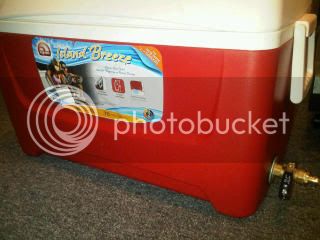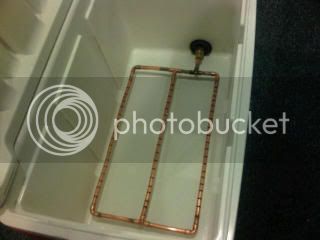If there's one thing that has been consistent in my all-grain batches, its my consistently low OG. Recently I've been adding DME after checking the Pre-Boil gravity, to off-set the gravity, but the last time I tried that my OG ended up WAY over. I know there's a million posts on efficiency, and I've read many of them, so after doing much of my own testing and evaluation, I figured I'd break down and ask for some help. Here is what I've troubleshooted so far:
Crush - I use a maltmill, and always seem to get a great crush out of it. Whether we hand crank it, or use the power drill, always seems to break it up well, everything ends up in small chunks and has a nice powdery topping.
Temperature - At one point my thermometer went WAY off, so I thought just getting a few more therm's would fix the problem. It helped, and I know my mashes hold good temp, but still didn't fix it completely.
Mash/Batch Sparging - This is one thing I've been trying to get down. I'm pretty good at getting the right amount out for my full boil, but my method has always been: Strike with water at temp to bring mash to 150-154, stir good and let sit for an hour or so(1.25-1.5qt/Lb Grain-whatever beersmith says to do). Now by the time I do my 1st runnings my temp is in the mid to high 140s, and I completely drain the tun. THEN I add around 180 (split sparges) stir and run off. Now I've been reading about adding this sparge water BEFORE draining, and bringing the whole mash temp up THEN draining. Would this help? I especially use the previous method, because I was doing 10g batches with a 10g mash tun. But with my 5gal batches, maybe I could try the latter method. (Sometimes I feel like I go against the grain with beersmith's mash settings. I changed it to *drain mash tun, but then I like to split the sparge up-one of the settings creates multiple sparges, but then I can't change the temp of them individually)
Boil Off - This is another area that I'm trying to nail down, because sometimes I use a big turkey fryer pot, sometimes I use the keggle for 10 gal batches. Of course the keggle is harder to obtain/keep a good boil, thus seems to boil off less. I had a vigorous boil in the turkey fryer on this last batch.
MLT Dead Space - Again another area that may be affecting my efficiency. My drain is several inches off the bottom, with slots on the top. Seems like I have quite a bit of deadspace in there(but even when I account for a gallon of deadspace, I still seem to miss)
(I haven't been checking the gravity on every running, but if that would help, what would I be looking for to ensure consistency? Also I have run the iodine test before, and its never failed, but I always allow plenty of time to convert. I have never checked the water quality in my area, but St Louis/St Charles has pretty good water.)
Here is the info from my last brew:
13.3lb grain
Strike with 4g of water @ 152(grain temp) - maybe should have been 5 because of MLT deadspace?
DRAINED roughly 2 gallons.
Sparged 2 gal @ 180 - Ran off 2 gal
Sparged 2.5 gal @ 180 - Ran off 2.5
Total of 6.5 g full kettle
Estimated Pre-Boil 1.058
Actual Pre-Boil OG: 1.044
(Added 2 lb DME towards the end of the boil to compensate)
Estimated Post-Boil 1.067
Actual Post Boil OG: 1.074
Boiled for 80 minutes
End Volume into Carboy - 5 gallons
I'm wondering if maybe instead of adding the DME, I should have just boiled off longer? If that's the case though, how long would I boil if my pre-boil gravity is low?
Looking back at this last brew, I didn't make the equipment adjustments, except choosing the 7.5g brewpot(I used my turkey fryer kettle for this 5g batch)/10g cooler MLT. The settings were only .25g lauter/tun deadspace...but even when I put in 1g with my full keggle specs, I seem to still consistently come out low.
I thought I found a crutch by adding the DME, but it seems that may not be the best route, and I really want to nail this down.
By the way, this was for a BIG IPA that I wanted to brew up to drink for my bday at the end of October. I'm calling it A Hoppy Birthday Ale The IBUs are about 80, so its not a bad thing my OG came in a little high. I threw in another 2oz of dry hops and tasted a sample yesterday...its delicious, already down to 1.012. I thought it may come out too bitter, but I combined FWH with 80min hops, and lots of aroma hops, and it seems to have blended nicely. Can't wait to keg it up
The IBUs are about 80, so its not a bad thing my OG came in a little high. I threw in another 2oz of dry hops and tasted a sample yesterday...its delicious, already down to 1.012. I thought it may come out too bitter, but I combined FWH with 80min hops, and lots of aroma hops, and it seems to have blended nicely. Can't wait to keg it up 
The good thing with homebrewing is no matter what the OG/FG, the end result still usually produces a damn good beer
Sorry for the long post, but I'd certainly appreciate any feedback or suggestions you all may have. Thanks again!
Crush - I use a maltmill, and always seem to get a great crush out of it. Whether we hand crank it, or use the power drill, always seems to break it up well, everything ends up in small chunks and has a nice powdery topping.
Temperature - At one point my thermometer went WAY off, so I thought just getting a few more therm's would fix the problem. It helped, and I know my mashes hold good temp, but still didn't fix it completely.
Mash/Batch Sparging - This is one thing I've been trying to get down. I'm pretty good at getting the right amount out for my full boil, but my method has always been: Strike with water at temp to bring mash to 150-154, stir good and let sit for an hour or so(1.25-1.5qt/Lb Grain-whatever beersmith says to do). Now by the time I do my 1st runnings my temp is in the mid to high 140s, and I completely drain the tun. THEN I add around 180 (split sparges) stir and run off. Now I've been reading about adding this sparge water BEFORE draining, and bringing the whole mash temp up THEN draining. Would this help? I especially use the previous method, because I was doing 10g batches with a 10g mash tun. But with my 5gal batches, maybe I could try the latter method. (Sometimes I feel like I go against the grain with beersmith's mash settings. I changed it to *drain mash tun, but then I like to split the sparge up-one of the settings creates multiple sparges, but then I can't change the temp of them individually)
Boil Off - This is another area that I'm trying to nail down, because sometimes I use a big turkey fryer pot, sometimes I use the keggle for 10 gal batches. Of course the keggle is harder to obtain/keep a good boil, thus seems to boil off less. I had a vigorous boil in the turkey fryer on this last batch.
MLT Dead Space - Again another area that may be affecting my efficiency. My drain is several inches off the bottom, with slots on the top. Seems like I have quite a bit of deadspace in there(but even when I account for a gallon of deadspace, I still seem to miss)
(I haven't been checking the gravity on every running, but if that would help, what would I be looking for to ensure consistency? Also I have run the iodine test before, and its never failed, but I always allow plenty of time to convert. I have never checked the water quality in my area, but St Louis/St Charles has pretty good water.)
Here is the info from my last brew:
13.3lb grain
Strike with 4g of water @ 152(grain temp) - maybe should have been 5 because of MLT deadspace?
DRAINED roughly 2 gallons.
Sparged 2 gal @ 180 - Ran off 2 gal
Sparged 2.5 gal @ 180 - Ran off 2.5
Total of 6.5 g full kettle
Estimated Pre-Boil 1.058
Actual Pre-Boil OG: 1.044
(Added 2 lb DME towards the end of the boil to compensate)
Estimated Post-Boil 1.067
Actual Post Boil OG: 1.074
Boiled for 80 minutes
End Volume into Carboy - 5 gallons
I'm wondering if maybe instead of adding the DME, I should have just boiled off longer? If that's the case though, how long would I boil if my pre-boil gravity is low?
Looking back at this last brew, I didn't make the equipment adjustments, except choosing the 7.5g brewpot(I used my turkey fryer kettle for this 5g batch)/10g cooler MLT. The settings were only .25g lauter/tun deadspace...but even when I put in 1g with my full keggle specs, I seem to still consistently come out low.
I thought I found a crutch by adding the DME, but it seems that may not be the best route, and I really want to nail this down.
By the way, this was for a BIG IPA that I wanted to brew up to drink for my bday at the end of October. I'm calling it A Hoppy Birthday Ale
The good thing with homebrewing is no matter what the OG/FG, the end result still usually produces a damn good beer

Sorry for the long post, but I'd certainly appreciate any feedback or suggestions you all may have. Thanks again!




